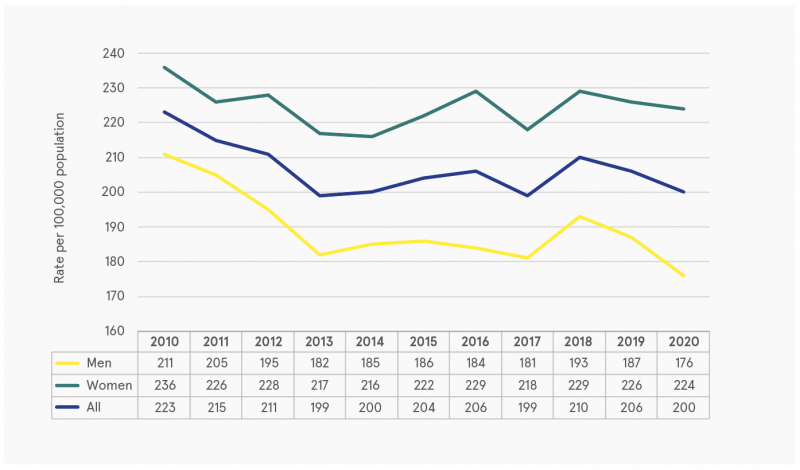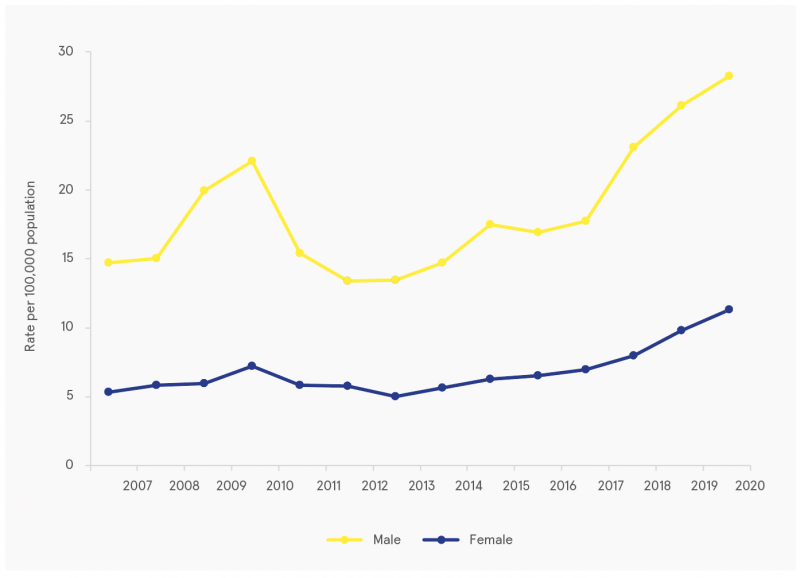Millar, Sean  ORCID: https://orcid.org/0000-0003-4453-8446
(2023)
National Self-Harm Registry annual report, 2020.
Drugnet Ireland,
Issue 84, Winter 2023,
pp. 35-37.
ORCID: https://orcid.org/0000-0003-4453-8446
(2023)
National Self-Harm Registry annual report, 2020.
Drugnet Ireland,
Issue 84, Winter 2023,
pp. 35-37.
| Preview | Title | Contact |
|---|---|---|
|
PDF (Drugnet 84)
1MB |
The 2020 annual report from National Self-Harm Registry Ireland was published in 2022.1 The report contains information relating to every recorded presentation of deliberate self-harm to acute hospital emergency departments in Ireland in 2020 and complete national coverage of cases treated. All individuals who were alive on admission to hospital following deliberate self-harm were included, along with the methods of deliberate self-harm that were used. Accidental overdoses of medication, street drugs, or alcohol were not included.
Rates of self-harm
There were an estimated 12,553 recorded presentations of deliberate self-harm in 2020, involving 9,550 individuals. Taking the population into account, the age-standardised rate of individuals presenting to hospital in the Republic of Ireland following self-harm was 200 per 100,000 population (see Figure 1). This was a decrease of 3% compared with the rate recorded in 2019 (206 per 100,000) and 10% lower than the peak rate recorded by the registry in 2010 (223 per 100,000).
In 2020, the national male rate of self-harm was 176 per 100,000 population, 6% lower than in 2019. The female rate was 224 per 100,000 population, which was 1% lower than in 2019. With regard to age, the peak rate for males was in the 25–29-age group, at 430 per 100,000 population. The peak rate for females was among 15–19-year-olds, at 779 per 100,000 population.

Source: National Suicide Research Foundation, 2022
‘All’ in the legend refers to the rate for both males and females per 100,000 population.
Figure 1: Person-based rate of deliberate self-harm, 2010–2020, by sex
Self-harm and drug and alcohol use
Intentional drug overdose (IDO) was the most common form of deliberate self-harm reported in 2020, occurring in 7,426 (62.2%) of episodes. As observed in 2019, overdose rates were higher among women (65%) than among men (58.6%). Minor tranquillisers and major tranquillisers were involved in 33% and 10% of drug overdose acts, respectively. In total, 33% of male and 48% of female overdose cases involved analgesic drugs, most commonly paracetamol, which was involved in 31% of all drug overdose acts. In 66% of cases, the total number of tablets taken was known, with an average of 28 tablets taken in episodes of self-harm that involved a drug overdose.
Although the proportion of self-harm presentations to hospital involving IDO in 2020 was similar to that recorded in 2019 (62%), there was an increase in self-harm presentations involving street/illegal drugs. Since 2007, the rate per 100,000 population of IDO involving illegal drugs has increased by 100% (from 9.9 to 19.6 per 100,000). The male rate has increased by 91% (from 14.6 to 27.9 per 100,000), while the female rate has increased by 111% (from 5.3 to 11.2 per 100,000) (see Figure 2).
Cocaine and cannabis were the most common street drugs recorded by the registry in 2020, present in 8% and 4% of overdose acts, respectively. Cocaine was more common among men than women and was involved in 23% of overdose acts by 25–34-year-olds. Cannabis was most common among men aged 15–24 years and was present in 11% of overdose acts. Alcohol was involved in 33% of presentations and was more often involved in male episodes of self-harm than female episodes (38% vs 28%, respectively).

Source: National Suicide Research Foundation, 2022
Figure 2: Trends in rate of intentional drug overdose involving illegal drugs, 2007–2020, by sex
Recommendations
In 2020, there was a further increase in the proportion of presentations by persons experiencing homelessness. The report authors noted that this group of individuals represents a particularly vulnerable population – at high risk of repetition and mortality from all causes – and that further work to examine the specific risk and protective factors associated with self-harm among persons experiencing homelessness is required.
1 Joyce M, Chakraborty S, O’Sullivan G, et al. (2022) National Self-Harm Registry Ireland annual report 2020. Cork: National Research Foundation. https://www.drugsandalcohol.ie/37441/
Repository Staff Only: item control page